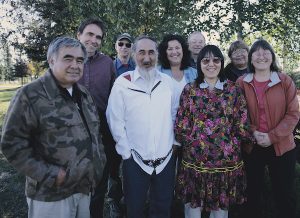
An EXTRACTION event
Tuesday, February 21, 2017
Digital Arts Research Center (DARC) 108
Join us from 5:30 -7:30 pm for Subhankar Banerjee, “Why should I care about the Arctic?: Politics of Extraction & Justice in the Near North.”
This artist talk is part of EXTRACTION, a research program exploring the industrial operations which abuse natural resources and thrive off of labor exploitation and racialized impoverishment.
This event is supported by Digital Arts & New Media. It is FREE and open to the public. Metered parking is available in the Performing Arts lot.
Alarmed by the realization that the Trump administration will be moving swiftly and aggressively to open up significant bio-cultural areas in the land and seas of Arctic Alaska to oil and gas development, this presentation will address the social significance and political potential of art. Focusing on what we might call “peripatetic photography,” Banerjee will consider how a photograph is not merely an object on a wall that may induce pleasure or spark intrigue and other human emotions but more importantly how it can operate as a portal to social-environmental activism and interdisciplinary scholarship. According to such a model, which Banerjee practices in his own work, photography holds the capacity to advance integration of knowledge across disciplines, practices across cultures, in order to mobilize resistance against destructive resource extraction.
A self-taught artist and writer and an accidental activist, Subhankar Banerjee is Lannan Chair of Land Arts of the American West and Professor of Art and Ecology at the University of New Mexico. His photographs have been exhibited widely, including at the Amon Carter Museum of American Art, Nottingham Contemporary and Biennale of Sydney; and writing published in anthologies and progressive media, including Ecocriticism and Indigenous Studies and TomDispatch. Over the past sixteen years his work primarily addressed resource wars, climate change, and indigenous human rights in the Arctic, and contributed to defeating and/or slowing down oil and gas development in some of the biologically and culturally significant places, including the Arctic National Wildlife Refuge, Teshekpuk Lake wetland, and the Beaufort and Chukchi seas. He collaborates closely with the Gwich’in and the Iñupiat indigenous communities in Arctic North America. Banerjee is editor of Arctic Voices: Resistance at the Tipping Point. He has been working on a long-term visual ecology (Arctic, desert, forest) trilogy on (non)human.
* Image credit: Subhankar Banerjee, After the Listening Session, photograph, 2006
